Full test of the new Cannondale Scalpel Hi-Mod 1 after more than 200 km pinning it
The presentation of the new Cannondale Scalpel 2021 has brought a new concept for XC, and no less was expected from a vanguardist brand that has been characterized by seeking creative and innovative solutions to improve each model. But to avoid the emotion of the first moment we decided to make a deep test and this is the result after more than 200 km.

In-depth test of the new Cannondale Scalpel 2021 after more than 200 km
According to the brand and as we saw in the presentation of the new Scalpel, it presents the lightest full suspension frame on the market. An aggressive mountain bike, which has undergone a major renovation. They have changed its geometry to continue moving in the direction of the XCO and XCM trends, maintaining the 100mm of front and rear travel and renewing its suspension system and kinematics to achieve more performance and better response in all types of terrain.
For the arrival of the latest generation of the Scalpel, the engineers focused on evolving its suspension system to combine the best of what was already on the market, the lightness of the monopivot system and the efficiency of the Horst Link system kinematics. Taking as a reference their beginnings in the first Scalpel in which the bending of the carbon itself was an active part of the suspension system. They have chosen to replace the pivot point bearings of the Horst Link system located in the pods with carbon plates, which perform a similar function to these and manage to maintain the low weight of a monopivot system.
RECOMENDADO

Ketone, the drink of military origin for which Dumoulin quits the MPCC
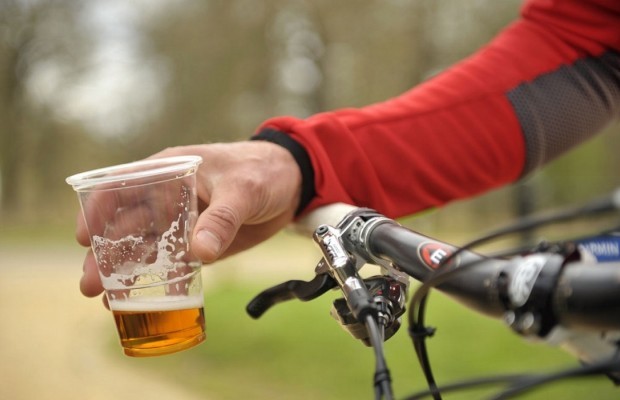
Benefits of not drinking a drop of alcohol

Puncture-proof SmartMousse for mountain bike, do you need it?

Here you can find 9 carbon full-suspension MTBs for less than 4000€
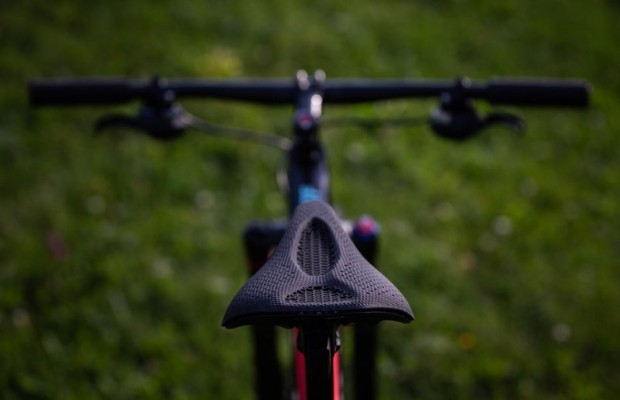
Specialized S-Works Power Mirror: the saddle to mark a before and after

Manuel Fumic is seriously injured after a heavy fall while training

This innovative rear suspension system is called FlexPivot and the new geometry possibly set the benchmark for the evolution of other brands in the XC bike segment.
We had a Scalpel Hi-Mod 1 model at our disposal a few days before its presentation, therefore we could test it out thoroughly for a few weeks and explain our feelings about this bike, without being guided by first impressions only, since the renovated Cannondale makes you fall in love at first sight.
Technologies applied in the Cannondale Scalpel Hi-Mod 1
FlexPivot
In this Cannondale Scalpel we find a BallisTec carbon frame, which has been completely renewed compared to its predecessor. The engineers were faced with the difficult task of improving an already well-functioning frame. Even so, bikes intended for XCO and XCM increasingly need a suspension system that works better, giving the rider more configuration possibilities. Analyzing this, they found themselves in the situation of improving the monopivot suspension system that, although it is not the best, it provides rigidity and lightness. On the other hand, if a Horst Link system was chosen, weight was added, so the solution was to improve the latter to obtain independence between pedalling forces and braking and try to get the benefits of the monopivot system.

To achieve this, they used their experience in carbon bending to add two sheets of this material to the bottom of the sheaths, just before they were joined to the tie rods to simulate a pivot point similar to the Horst link pivots without the need to add bearings or bushes. This thin carbon section is designed to provide vertical bending, proving to be very stiff against forces in other directions, so there is no loss of rigidity or pedaling efficiency and according to Cannondale only 2 kg of force is needed for us to start noticing its benefits. With this we obtain a new simple and effective rear suspension system, which they have called FlexPivot.
This system improves the function of the Horst Link pivots, as it avoids maintenance, takes weight off the assembly, and also eliminates possible noise at the pivot points due to its simplicity. The FlexPivot suspension offers the dynamic performance of an ultra-light system while exponentially improving traction, acceleration and control.
Both pods have a rubber coating right in the area of the FlexPivot which, in addition to providing protection, is in line with the aesthetics of the Scalpel frame.

Proportional Response
In terms of construction, they have introduced Proportional Response technology, already used in other models of the brand. It is based on the exclusive design of frame and swingarm depending on each size, creating its own kinematics so that all bikers find a similar performance and feeling of the bike regardless of their weight or height.
This is done by taking into account a number of factors such as: different volumes and sections of the tubes, arrangement of the carbon at each point in the frame, operating kinematics based on the different centre of gravity in each size and location of the suspension pivot points. All this to obtain the same response of the bike and riding sensation in all sizes.
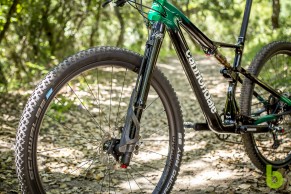
With the arrival of the FlexPivot and the introduction of Proportional Response technology, a more progressive suspension travel has been obtained in comparison with the previous model, which allows us to improve the speed of passing through rough terrain, whether downhill or where we have to pedal.
Chainstay Garage
Another change that is made in the new frame is the union between swingarm and front triangle, this is joined to the same in the opposite way to how we are used to see. The swingarm sleeves are inserted into the vertical tube, which has increased its section in the bottom bracket area to make room for it. This concept has been called Chainstay Garage, which increases stiffness in the bottom bracket area and reduces weight by using less material.
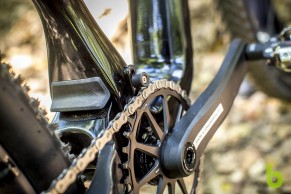
This construction has meant that the sheaths are one millimetre longer than the previous version, measuring 436 mm. In return, a larger wheelbase is also achieved, allowing tyres of up to 2.4" to be fitted.
To protect the joint from dirt and mud they have mounted a small rubber fender that does not detract from the aesthetics of the bike.
AI
Cannondale's long-standing AI transmission concept is maintained in the new version of the Scalpel. A system that shifts the chain line to give, at the rear wheel, a greater angle to the spokes on the cassette side of the rim. This results in a more balanced spoke tension between the two sides of the wheel and significantly increases lateral stiffness, as well as making the wheel more compact.
The downside is that it requires special sized components for Cannondale transmissions, but this is common and component manufacturers are increasingly considering it when designing their products.
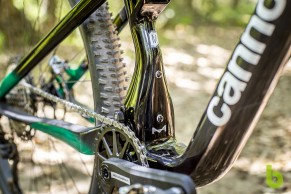
Although all this is significant in terms of technology and design changes, it does not end here. At Cannondale they are considering the use of this bike for XCM and as such the frame has the ability to fit two bottle cages without any problem from size M upwards. This is something that although it may seem insignificant to many may be a very important point in their choice of bike.
It has the Speed Release rear thru axle, of its own design, which combines the stiffness advantages of a conventional thru axle with the speed of wheel change of a traditional quick release.
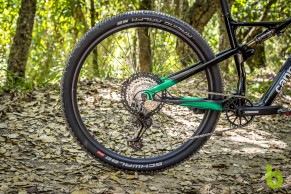
The routing is internal and simple, called DirectLine Cable Routing. It has internal guides that favor the maintenance. In addition, if you are one using a telescopic seat post, it also comes prepared to place the internal routing.

To finish off all the suspension hardware and axles are new too, easier to maintain according to Cannondale.
All these changes in the design and construction of the Scalpel frame have led to a weight saving of 200 gr compared to the previous version, leaving the Hi-Mod frame at only 1910 gr, including shock, lock, screws... which makes it one of the lightest full suspension frames on the market.
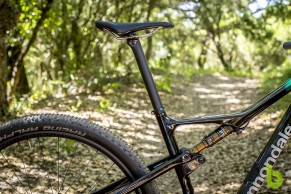
Cannondale Scalpel Hi-Mod 1: Fork, geometry and components
The new geometry and the Lefty fork are a perfect combination
To accompany this painting we find the Lefty Ocho Carbon, already presented in 2018 and which for some is the best XC fork ever created. Thanks to its stiffness and smoothness of operation it gives us great sensitivity and riding precision. It is very stable, maintaining its position in strong supports. On the other hand, as it is single-arm, apart from its peculiar aesthetics, it gives us a great wheel arch and the advantage of repairing punctures without having to dismantle the wheel.

The frame has reduced the size and the height of the handlebars can be lowered by 7 mm. In addition, when using conventional stems we can play with an infinite number of combinations of length and angle to be able to adapt the position of the biker to the bike even more.
One of the important innovations we found is that the locking system of both suspensions is now push-to-lock, something that was demanded by many users since it is a more natural handling and making sure the bike is not being locked in full downhill by the involuntary touch of the lock button.
A modification of the quick release clamp anchorage system is expected soon. This is currently done by pressing a safety button and turning a half turn of an allen key screw, but is expected to be done without using any tools.
The new bracket will be compatible with all Lefty Ocho's and can be purchased separately as an upgrade.
As expected, one of the most relevant points of this new Scalpel is the renewal of the geometry to adapt to new trends. Applying the Proportional response technology, certain points are revised to obtain better kinematics and performance, but other parts have also been taken into account.

Now the geometry is more radical, the bike is longer and lower. The wheelbase has increased, the Reach has increased by 10mm and the Stack has decreased by 20mm (435mm Reach and 591mm Stack in size M of the test bike). A lower center of gravity has been obtained and thanks to the longer Reach and the more relaxed steering angle, which goes from 69.5º to 68º, the Scalpel is more stable and easier to handle.
In the search for more efficient pedalling, the angle of the seat tube has been increased to 74.5º and, although the seat stays are 1 mm longer (436 mm), it is still a fairly good size to be reactive and effective in climbing.
The suspension rod decreases in size and changes location to be fixed to the riser to achieve Cannondale's desired kinematics.
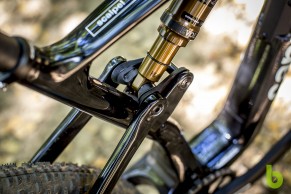
Finally, we have to add the offset of the Lefty Ocho which is 55 mm. Longer than usual for this type of bicycle and which, together with the 80 mm stem, follows the OutFront Steering Geometry concept, another of the new trends within the XC. With the longer offset the wheelbase is increased, helping to increase stability. In addition, this offset helps to counteract the slow reactions in slow areas caused by the relaxed steering angle, since a more contained trail measurement is achieved.
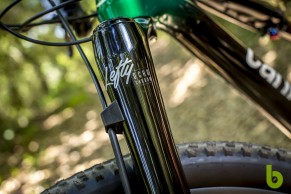
With this geometry it has been possible to improve in all points. You gain stability and safety in fast areas and manoeuvrability in steeper areas.
Premium and exclusive components
Transmission
The Scalpel has a transmission, mostly by Shimano. The shifter and rear derailleur are XTR, of which we can add little of their great performance and reliability. For the cassette and chain they have chosen to use the XT models of 10-51T development. While we would have liked the XTR cassette and chain to be included in a top of the range bike, they work well and, as they are parts that are subject to wear and tear, we can always use an XTR when we have to change ours.
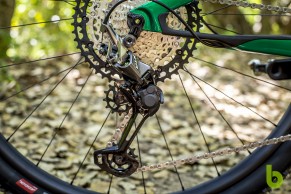
To complement the Shimano group and as usual in Cannondale, it mounts Hollowgram cranks of the last generation, hollow and aluminum, which have renewed providing them with self-extraction, more width and stiffness, while they have managed to reduce its weight to 172 g each. They have included a new crankset anchoring system and come standard with a 34-tooth chainring that gives it a good transmission ratio. This is something that we see as very appropriate in these high-end bikes designed to offer great performance and with a clear view of being used in competition, since riding them with smaller chainrings will force us, sooner or later, to change it for a larger one given the developments of the new cassettes. These new cranks are compatible with previous models, but it will be necessary to change the axle. They will be available in lengths from 165 to 175mm.
Wheels
The chosen wheels are an assembly of the brand itself. It consists of 25 mm wide internal Hollowgram carbon rim following current trends, DT-Swiss Competition Race spokes and rear hub from the same brand. Obviously the front wheel has a specific hub for lefty and the rear wheel has a specific lug to integrate it into the AI technology. These are Cannondale's own technologies that only they use today, but that result in a stiff and quite light wheel set, that during our test worked great.

It is equipped with Schwalbe Racing Ray EVO front and Racing Ralph EVO rear tyres as standard, both in 2.25" width and with reinforced SnakeSkin carcass. These tires have been tested in the World Cup by the Cannondale team and, unlike other brands, they are tubeliss as standard, so you can get on the road right away.
Brakes
It mounts the well-known XTR brakes, guaranteed to perform and with more than enough braking power to stop this mountain bike. They come with 160mm XT discs both front and rear.

Handlebar and stem
The Cannondale One 760mm flat carbon handlebar may seem too long at first glance, but it certainly adds to the Scalpel's rideability in curves, and certainly once you've been on the bike for a few minutes you don’t feel it that long. The stem is also branded, an 80mm long aluminium Cannondale One, which is a standard measurement on most XC bikes. One detail we liked is that it has ESIGrip grips, which give us a very good feel and grip, avoiding the use of low quality grips.
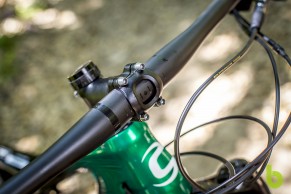
Saddle and seat post
On the other hand, we find the Prologo Dimension NDR saddle, which we think is very comfortable, although it is true that we would have liked to have used a superior model, according to the price of the bike and which would help to reduce a few grams on the scale. It joins the frame with the Enve Carbon seatpost which, in this case, does match the quality of the Scalpel finish.
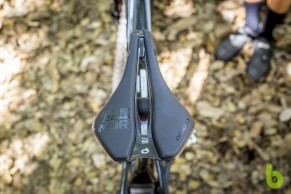
Stash, a very successful novelty
The new Scalpel frame incorporates another interesting novelty, the STASH Kit. A plastic support that is integrated into a slot that has the diagonal tube right in the area of the bottle cage and is attached to the frame with screws. It contains everything you need for quick repairs: a Fabric 8 in 1 multi-tool that can be removed from the side, a Dynaplug tubeless repair set with several plugs and an area for carrying a Co2 cylinder or a mini-pump.

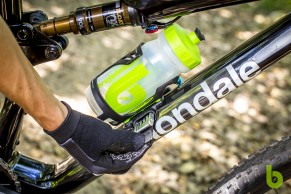
We think it's a great idea, since it only adds 100 g of weight, but it can be very useful in case we have to make a repair in the middle of our route, or if you are one of those who carry the bike inside your vehicle and need to remove the front wheel. You also have the option of remove it and leaving only the bottle cage, if you prefer to carry your tools in your rucksack or jersey.
Front wheel sensor
A Cannondale sensor, developed in collaboration with Garmin, comes standard on the front wheel. Once linked to our Smartphone, we have the ability to get accurate speed, time, route and distance information, as well as logging your bike for maintenance reminders, suspension information...
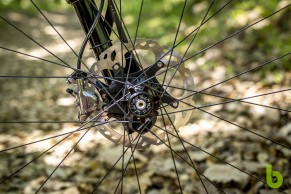
It records up to 30 routes or workouts before it needs to be synchronized with the App. No need to press the start button, as it starts recording from the moment you start pedaling
Finally, we would like to comment that it comes standard with protections in the parts of the frame where the bike may be more likely to get scratched, which is something to be appreciated.
Test and sensations on the Cannondale Scalpel Hi-Mod 1
As we said at the beginning, we have taken our time to thoroughly test the new Cannondale Scalpel, with the intention of not letting ourselves be guided by the good impression it makes just by looking at it. At first glance you can see how low the frame is, you even stand next to it thinking it may not be your size, but nothing could be further from the truth. Once we put handlebars and saddle to our measure you see that if it is the right size and that it will be a manageable bike.

We mounted the pedals, the garmin stand, the bottle holder and the Stash kit with the multi-tool, the plugs and the CO2 cylinder and we passed it through the scale throwing us a weight of 10.5 kg. In our opinion, this is a very competitive weight as it is a full suspension bike and it is equipped with everything necessary for a trip to the mountains.
We take the first pedalstrokes on the Scalpel. The feeling is that we are very tight with the suspension open and we chose to adjust the pressure of the shock by lowering some PSI thinking that it was excessive for our weight and that once we entered uneven roads we would lose some traction. We started to find a flat terrain with potholes where you can notice that the suspension starts to work and gives us a feeling of stability and comfort when riding at high speeds, no matter if we can't avoid some bumps, as they are absorbed almost without noticing them.

We face the first uphill climbs where at first we miss an intermediate position to lock the suspension, as we appreciate that the shock is acting too much. Since we only have 2 positions, open or locked, we decided to put the shock pressure back where Cannondale recommended it for our weight. With this pressure adjustment the suspension system turns and we repeat the climbs with a different feel, the bike becomes firmer and we ride faster. Here you can see that we have also worked on modifying the setting of the shock to work in line with the new kinematics and performance of the FlexPivot, giving a feeling of being closer to a Horst Link system but firmer than if we really had a bushing or bearing.
We arrive at a more technical area where the performance of the suspension is even more remarkable. In downhills it reads the terrain perfectly, it is very stable and gives us a confidence that leads us to use the brake less and allows us to go down very fast without going off the chosen route. The Lefty Ocho fork is firm and we make stronger supports. We are leaning on the bike but thanks to the open steering angle and the offset of the fork, the wheel is quite far forward and we have no problem absorbing obstacles that we find on the way down, without fearing that a mistake will throw us over the handlebars. It really gives you a feeling of being in control at all times.

It is in areas with twisted curves where it is penalising that the Scalpel is a little longer, although it is true that thanks to its lightness and the stiffness of the fork we can move it easily and make it enter the turns.
The 100 mm of front and rear travel now has a more similar, more progressive performance, more like that of the Lefty fork. In the first downhills we can see how we still have a lot of shock travel to take advantage of but at no time we noticed that the rear wheel was jumping. This makes us think that maybe we will go again with a hard suspension, so we look for more aggressive downhills and we start to see how it is not like that, the travel is better and better and as it reaches its final part it gets harder to avoid it to stop easily. Whether your ride is very aggressive or quieter, the suspension offers incredible performance, leaving no one indifferent.
In fast and explosive climbs it is surprising how agile and reactive it is. It' s got incredible traction. The rear wheel doesn't come off the ground, the shock absorber barely works and that's where you realize that the FlexPivot system comes into play, offering a certain resistance to be activated, so that when you pedal, you barely lose your grip. It works more like a monopivot and if we add the stiffness and lightness that have been achieved with this frame, it moves quickly and invites us to stand and continue giving the best of oneself in the climb.
When the climb becomes more rocky, the flexPivot starts to flex, bringing into play the travel of the shock so that the rear wheel reads the ground perfectly and we do not lose traction at any time. In this type of situation is where the suspension system is more like a Horst Link, making the pedaling forces independent.

After that, the feeling that Cannondale's new suspension system has given us is that we're looking at a system halfway between the monopivot and the Horst Link that tries to improve on the shortcomings of each. Offering us a good, stable and effective performance that will surely serve as a reference for many.
And yet, the minutes have passed on the bike, the terrain has changed and we have forgotten to use the suspension lock. A sign that the system is working properly so you don't need it. Even so, and after enjoying the mountain with the new Scalpel, for the road sections if we use lock control Fox. As we all know, the Lefty fork in this position is very firm, but it is surprising that the frame is just as firm, giving a feeling that we are riding a hardtail bike.
CONCLUSION
In conclusion, this is a bike focused on competition, but also with the intention of making us improve in all areas. Thanks to its new updated geometry, its new improved suspension system and the improvements introduced in the design and construction, we are have a lighter and more rigid mountain bike. More stable at high speeds, with better traction on uneven ground and more agile in slower areas. All this will make us improve, especially in the hardest and most difficult trails, where we could be penalized before.
In addition to its good performance, it is well finished and has many details as standard. The quality of the components, the inclusion of the Stash Kit, the tubuless wheels as standard, the frame protectors... are small things that give this bike even more value.

Although as a negative part we can say that it has some components that are specific to this brand, it is something that component manufacturers take into account and is also something that is more and more common in other brands.
This is a high-end mountain bike, in a premium bike price range but when you try it out you realize it's definitely worth the investment.
Test Model Specifications - Cannondale Scalpel Hi-Mod 1
- Frame: Cannondale Scalpel 100, BallisTec Hi-Mod Carbon, Proportional Response, FlexPivot, ChainStay
- Fork: Lefty Ocho Carbon 100mm
- Shock: Fox Float DPS Factory EVOL 100mm
- Wheels: HollowGram 25
- Hubs: Lefty 60 front, DT Swiss 12x148 rear
- Tires: Schwalbe Racing Ray front, Schwalbe Racing Ralph rear (29x2,25")
- Cranksets: HollowGram
- Transmission: Shimano XTR/XT 1x12
- Handlebar: Cannondale One Flat, Carbon, 760 mm
- Stem: Cannondale One, Aluminum, 80 mm, 7
- Grips: ESI Silicone
- Brakes: Shimano XTR M9100 160/160mm
- Saddle: Prologo Dimension NDR, Tirox rails
- Seat Post: ENVE Carbon
- Connectivity: Cannondale Wheel Sensor
- Weight: 9,76 kg
- Price: 7.999€